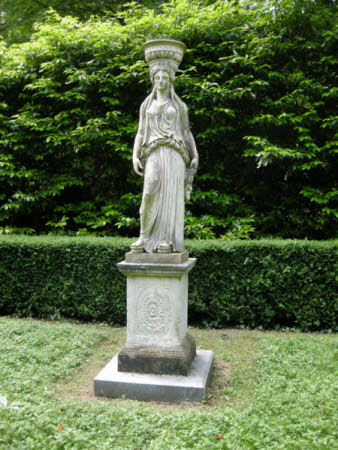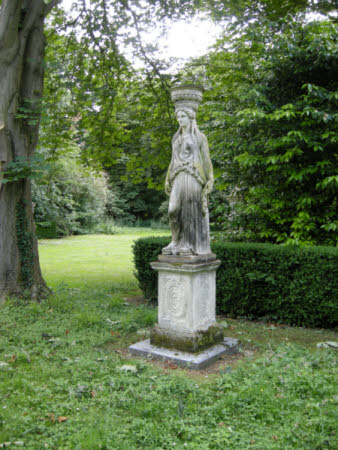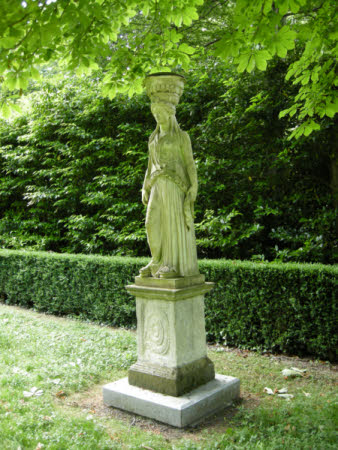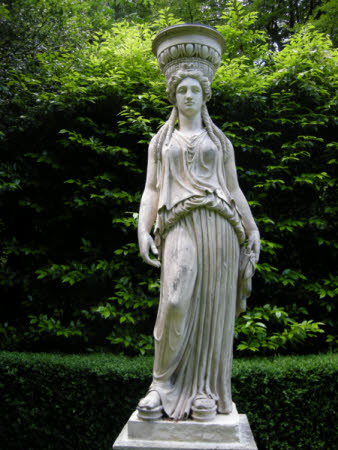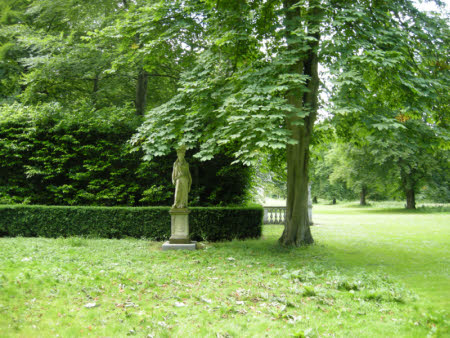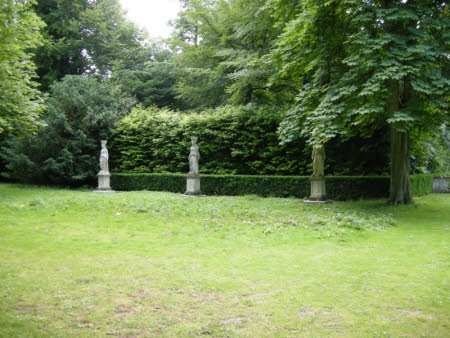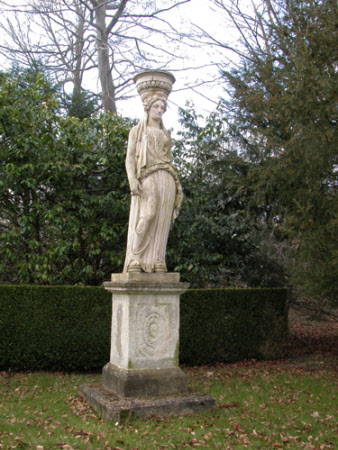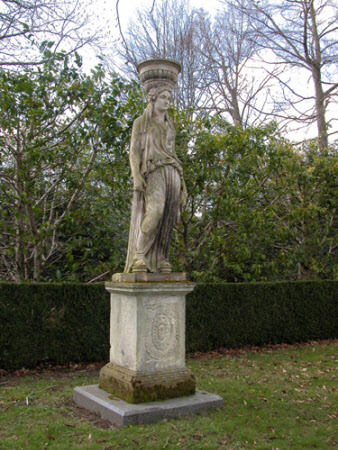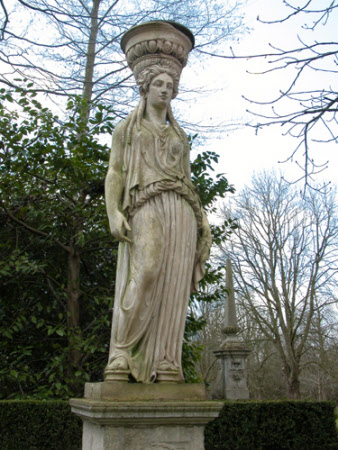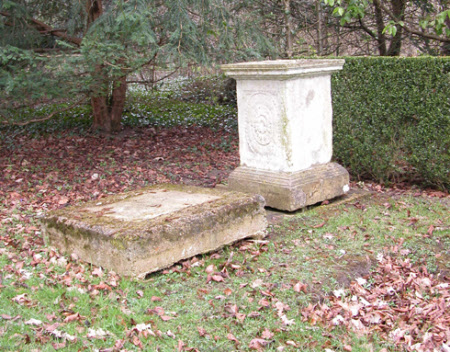Six caryatids
Coade
Category
Art / Sculpture
Date
1793 (signed and dated on three of six)
Materials
Coade stone
Place of origin
Lambeth
Order this imageCollection
Anglesey Abbey, Cambridgeshire
NT 516655
Caption
Eleanor Coade developed Coade stone, an innovative artificial stone made from a highly durable type of ceramic that was perfect for outdoor use. Her ornamental sculpture added an enduring beauty to hundreds of gardens and buildings. Coade established her Lambeth manufactory at a time when British industry was dominated by men. In 1769 she took over the premises of an ailing artificial stone factory run by Daniel Pincot, developing the new, closely guarded formula that would bear her name. Pincot continued in the business but was dismissed by Coade a few years later for falsely presenting himself to clients as its proprietor. She made her position abundantly clear in an advert in The Daily Advertiser in September 1771 – ‘no Contracts or Agreements, Purchases or Receipts, will be allowed by her, unless signed or assented to by herself’ – she was indisputably in control of this business. Coade brought in sculptor John Bacon (1740–99) as superintendent and he improved the quality of design, working mostly in the fashionable Neoclassical style. She supplied mould-made architectural ornaments, garden sculpture and monuments to the most eminent architects of the day, including Robert Adam, James and Samuel Wyatt, and John Soane. The caryatids in the gardens at Anglesey Abbey, Cambridgeshire are probably from a group used by Soane in the rebuilding of Buckingham House, London. The company’s 1784 catalogue includes 778 different designs, including one matching an urn (left) now at Ardress House, County Armagh. In 1799 Coade went into partnership with her cousin and the business was renamed Coade & Sealy. A London showroom was opened and the company was granted Royal Appointments by George III and the Prince Regent, who were clients. Coade continued to run her business until her death in 1821, aged 88. Next time you are wandering through a garden and spot what looks like a carved stone urn or figure, perhaps look again – is it what it seems, or has Mrs Coade’s formula tricked you?
Summary
Coade stone, six caryatids, Coade & Sealy, 1793. Six over-life-size caryatids moulded of Coade artificial stone and based on figures from the Porch of the Caryatids of the Erechtheion on the Acropolis in Athens and on caryatids at Hadrian’s Villa, Tivoli. The bases of three of the caryatids inscribed ‘COADE LAMBETH 1793’, with two inscribed ‘COADE LAMBETH’ and ‘COADE LONDON’. Removed from Buckingham House, 1908. The caryatids as Greek maidens wearing peplos gathered in the palms of their proper left hands, with their proper right arms resting by the side. Standing on platform sandals with weight bearing on their proper left legs, their proper right knees bent forward. Hair coiffed in waves with centre parting and knot and long ringlets falling over shoulders. The heads surmounted by capitals enriched with bead-and-reel and egg-and-dart moulding. Mounted on Coade stone bases and stone pedestals enriched with rosette mouldings.
Full description
On the basis of the date ‘1793’ inscribed on three of the bases, these statues have been convincingly identified as among those which once held up the dome of the oval lantern above the staircase at Buckingham House, Pall Mall, rebuilt by John Soane (1753-1837) for the first Marquis of Buckingham in 1792-95 (Kelly 1989, p.251). A preliminary design by Soane (reproduced in Stroud 1992, pl.92) showing a section of the staircase hall includes seven caryatids, five along the side and one at each end, suggesting a complement of either twelve or fourteen in all. However a later watercolour by Soane shows four caryatids arranged round the end of the oval hall, rather than along the side, where there is no longer a cornice (reproduced in Stroud 1992, pl.93, and in Saumarez-Smith 1993, no.293), indicating that the design was altered, and Soane was eventually only billed for eight figures (Kelly, art. cit). The caryatids were presumably bought by Lord Fairhaven for Anglesey Abbey at some point after 1926, the figures retaining traces of black paint used to bronze them for Buckingham House. A photograph reproduced by Lanning Roper (1964) shows the caryatids at the junction of Cross Avenue, Anglesey Abbey, surmounted by ‘enormous terracotta baskets of a later date’, possibly the form in which they were bought by Lord Fairhaven, but subsequently removed (Roper 1964, p. 50, pls. 23b, 24b). Buckingham House appears to have been the first use of Eleanor Coade’s ‘Caryatid’ model, designed before Lord Elgin brought back the Pentelic marble caryatid from the Erechtheion (1816; British Museum, London, inv.no. 1816,0610.128). It evidently became a favourite with Soane, who, in 1795, ordered 12 of the same for the dome of the Rotunda of the Bank of England. Without the surmounting capitals, the caryatids can also be seen on the exteriors of Pitzhanger Manor, Soane’s country house in Ealing (1802), and on the loggia of No. 13 Lincoln’s Inn Fields (1812), his London town house. Coade ornament was used in one of Soane’s earliest dated buildings, a house at Adam’s Place, Southwark (1780-2), and continued to be used throughout the architect’s career, long after Eleanor Coade’s death. Soane’s personal copy of the 'Etchings of Coade's Artificial Stone Manufacture', a collection of 778 etched designs published in letterpress in 1784, is in the library of Sir John Soane’s Museum, London (no. 6861). Alice Rylance-Watson 2019
Provenance
Presumably acquired by Urban Huttleston Rogers Broughton, 1st Lord Fairhaven (1896-1966), after 1926; bequeathed by Lord Fairhaven in 1966 to the National Trust with the house and the rest of its contents.
Credit line
Anglesey Abbey, The Fairhaven Collection (The National Trust)
Makers and roles
Coade, manufacturer
References
Kelly 1985: Alison Kelly, 'Coade stone in Georgian architecture', Journal of the Society of Architectural Historians of Great Britain 28 (1985), pp. 71--95., p. 89. Kelly 1989: Alison Kelly, ‘Sir John Soane and Mrs Eleanor Coade’, Apollo, April 1989, pp. 247-253., p. 251. Kelly 1990: Alison Kelly, Mrs Coade's stone, Upton-upon-Severn 1990, pp. 134-5. Stroud 1984: Dorothy Stroud, Sir John Soane, Architect, London 1984, pls. 92-3. Saumarez-Smith 1993: Charles Saumarez Smith, Eighteenth Century Decoration: Design and the Domestic Interior in England, New York, 1993, no. 293. Roper 1964: Lanning Roper, The Gardens of Anglesey Abbey, Cambridgeshire. The Home of Lord Fairhaven, London 1964, p. 50, pls. 23b, 24b. Christie, Manson & Woods 1971: The National Trust, Anglesey Abbey, Cambridge. Inventory: Furniture, Textiles, Porcelain, Bronzes, Sculpture and Garden Ornaments’, 1971, p. 170. Conroy, Rachel, Women Artists and Designers at the National Trust, 2025, pp. 72-73



